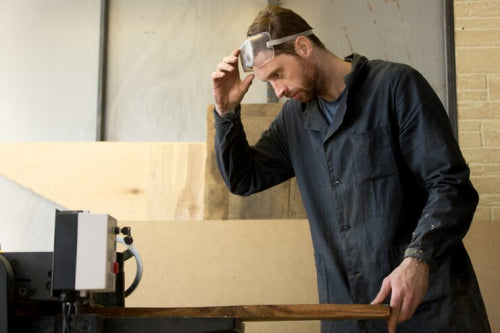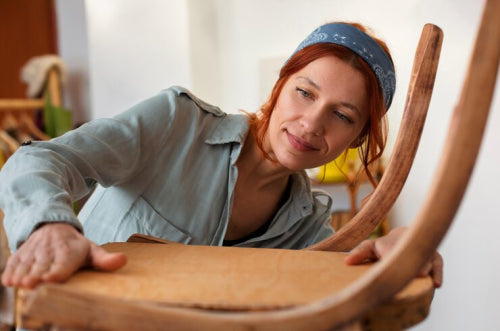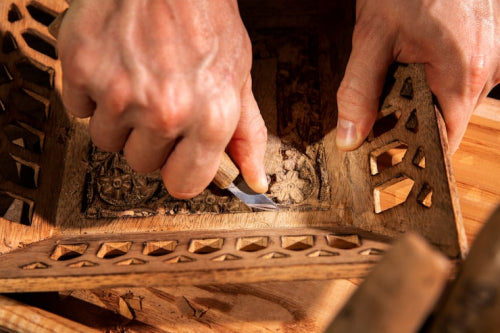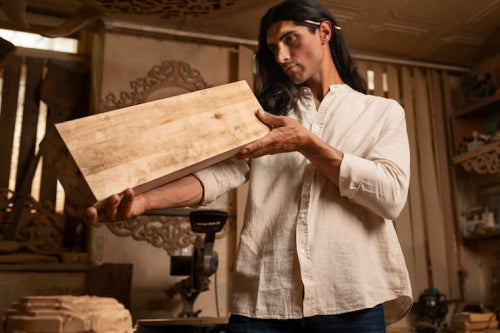In a Jaipur workshop, the steady rhythm of a mallet striking a chisel reverberates, crafting a Sheesham wood joint so precise it seems to defy time. This is joinery not mere carpentry, but an ancient art where wood interlocks without nails, creating bonds as enduring as the culture they embody. From Bangalore's innovative design hubs to Chennai's temple workshops, India's artisans are preserving a craft that marries heritage with modernity, shaping a handcrafted furniture renaissance that resonates globally.
Mass-market furniture lacks heart, filling rooms with bland, short-lived pieces. Frequent breakdowns spark frustration, as replacements erode style and sentiment. At MMC Wood Creations, Udaipur artisans shape heirloom furniture with enduring craftsmanship and cozy elegance, creating pieces that echo your identity, ensuring your home radiates warmth and timeless connection. Shop Now!
The Surprising History of Joinery Techniques: India's Enduring Craftsmanship
Joinery is the silent backbone of woodworking, where timber pieces fit together with such precision they appear as one. In India, this craft is a cultural cornerstone, threading through centuries from ancient temple builders to today's urban studios. Cities like Jaipur, Bangalore, and Mumbai are guardians of distinct joinery traditions, each infusing the craft with local character while balancing durability and elegance. As global demand for sustainable, authentic design surges, India's joinery techniques are experiencing a revival, blending age-old methods with cutting-edge innovation.
In Rajasthan's sunlit workshops, Jaipur and Jodhpur artisans have perfected the mortise-and-tenon joint, slotting a tenon into a carved mortise to craft furniture fit for royalty. In Bangalore and Hyderabad, dovetail joints interlocking wedges of teak or rosewood create cabinetry that is both functional and visually striking. Coastal Kolkata and Chennai carpenters rely on wooden dowels and interlocking pegs, tailored for humid climates where metal corrodes. These regional nuances, documented by the National Institute of Design in Ahmedabad and the Crafts Council of India in Chennai, highlight joinery's deep ties to local materials and traditions.
A Legacy Carved in Wood
Indian joinery's roots trace back to Chennai's temple carpenters, who crafted intricate wooden gopurams designed to endure monsoons. In colonial Mumbai, artisans adapted European dovetail techniques for British elites, merging them with local hardwood mastery. Today, these methods remain largely unchanged. Pune and Ahmedabad workshops use mortise-and-tenon joints for seamless chair frames, while Mumbai's boutique studios employ dovetails for elegant drawers. Hyderabad's carpenters favor butt and lap joints for sturdy, large-scale furniture, echoing the city's history of grand wooden structures.
Modern demands are reshaping this craft. Bangalore workshops now use kiln-dried hardwoods and non-toxic sealants, ensuring joints meet urban sustainability standards without sacrificing strength. This shift reflects a broader trend: Indian joinery is not just enduring but evolving, aligning with eco-conscious consumer values while preserving its core artistry.
Where Tradition Meets Innovation
Step into a Bangalore furniture cluster, and you'll hear the hum of CNC machines blending with the clatter of hand tools. These computer-guided cutters enhance the precision of traditional joints, enabling artisans to scale production while maintaining quality. In Ahmedabad, design studios experiment with hybrid joinery, combining hand-carved details with AI-driven 3D modeling for bespoke creations. Jaipur's workshops fuse brass inlays with classic wooden joints, producing furniture that feels both timeless and modern.
A Mumbai boutique workshop exemplifies this blend, using 3D modeling to design intricate joinery patterns before hand-finishing each piece to preserve its soul. The MSME Ministry's 2023 Craft Cluster Report notes that such innovations have propelled India's handcrafted furniture sector, with small workshops rapidly adopting technology. The CEEW India's Sustainable Design Index reports that 68% of urban Indian consumers prioritize eco-friendly furniture, a demand met by joinery's durability and repairability.
Globally, the builder's joinery market, valued at USD 80.36 billion in 2025, is projected to reach USD 99.91 billion by 2030, growing at a 4.45% CAGR. This growth is driven by green-building regulations, engineered-wood advancements, and digital manufacturing that reduces waste and lead times. Innovations like mass-timber code upgrades and carbon-credit monetization are enhancing project yields, despite challenges like raw-material volatility and labor shortages. Engineered solutions and cellular wood panels are expected to grow at 5.87% and 6.77% CAGRs, respectively, signaling a robust future for joinery-driven craftsmanship.
Challenges to a Timeless Craft
Yet, preserving joinery is no easy feat. In Chennai and Kolkata, woodcraft schools struggle with declining apprenticeships as younger generations chase tech-driven careers. Hyderabad and Pune face dwindling supplies of native hardwoods like teak and Sheesham, forcing reliance on imported or less durable alternatives. The India Trade Promotion Organisation reports that machine-made furniture captured 45% of India's domestic market in 2023, posing a threat to artisans. Balancing traditional handwork with sustainable sourcing remains a challenge, as artisans navigate rising costs while staying true to their craft.
Despite these hurdles, joinery's resilience shines through. Its ability to create furniture that lasts generations disassembled and repaired as needed offers a counterpoint to disposable, mass-produced pieces. Artisans are adapting, sourcing eco-certified materials and refining techniques to meet modern standards without losing their heritage.
A Market on the Rise
Urban India is driving a surge in demand for handcrafted furniture. In Bengaluru, Pune, and Mumbai, consumers are drawn to the authenticity and longevity of solid wood pieces. Jaipur and Ahmedabad workshops are gaining global traction, with exports to luxury markets in Europe and North America rising by 18% annually, according to the MSME Ministry. Joinery's circular design furniture that can be taken apart and repaired aligns with sustainable consumer trends, giving it a competitive edge.
Government initiatives are fueling this revival. The GI Tag Scheme for Jaipur woodworking and Skill India Mission's artisan upskilling programs are empowering craftsmen to preserve and innovate. These efforts are helping small workshops compete in a market increasingly dominated by tech-driven disruptors and large building-materials conglomerates.
A Future Rooted in Heritage
Joinery's future is being shaped by education and innovation. CEPT University in Ahmedabad and IICD Jaipur are updating curricula to teach heritage crafts alongside modern design technology. At IIT Madras and IISc Bangalore, researchers are exploring bamboo composites and recycled woods for hybrid joinery, merging sustainability with tradition. Industry forecasts predict India's handcrafted joinery furniture market will reach ₹8,000 crore by 2030, growing at a 12–14% CAGR, fueled by the “heritage-meets-modern” trend. A Jaipur artisan collective captures the essence: “Machines can shape wood, but only hands give it life.”
The Art of Lasting Connections
Joinery is more than a craft it's a testament to India's ability to weave tradition with progress. Each joint, whether carved in a Jaipur workshop or precision-cut in Bangalore, embodies a philosophy of strength, beauty, and balance. For designers, manufacturers, and buyers, joinery offers not nostalgia but a vision of sustainable craftsmanship that endures. As you trace the smooth edge of a handcrafted table in a Mumbai showroom, you're not just feeling wood you're touching a legacy that continues to shape the future, one seamless joint at a time.
Frequently Asked Questions
What are the traditional joinery techniques used in Indian furniture making?
Indian artisans primarily use three traditional joinery techniques: mortise-and-tenon joints (common in Jaipur and Jodhpur for royal furniture), dovetail joints (used in Bangalore and Hyderabad for cabinetry with teak or rosewood), and wooden dowels with interlocking pegs (favored in coastal cities like Chennai and Kolkata for humid climates). These techniques allow wood pieces to fit together precisely without nails or screws, creating furniture that can last for generations and be disassembled for repairs.
How is modern technology changing traditional Indian joinery craftsmanship?
Indian joinery workshops are successfully blending traditional hand-crafting with modern technology like CNC machines and 3D modeling software. Bangalore furniture clusters use computer-guided cutters to enhance precision while maintaining artisan quality, and Ahmedabad studios combine AI-driven design with hand-carved details for bespoke pieces. This hybrid approach has helped small workshops scale production and meet the growing demand from eco-conscious consumers, with 68% of urban Indians now prioritizing sustainable furniture.
Why is handcrafted joinery furniture becoming more popular in India?
The handcrafted joinery furniture market in India is projected to reach ₹8,000 crore by 2030, growing at 12–14% annually, driven by several factors. Urban consumers increasingly value the authenticity, durability, and sustainability of solid wood furniture that uses traditional joinery techniques. These pieces align with circular design principles they can be disassembled and repaired rather than discarded and exports to luxury markets in Europe and North America have risen 18% annually as global demand for sustainable, heritage-inspired design continues to grow.
Disclaimer: The above helpful resources content contains personal opinions and experiences. The information provided is for general knowledge and does not constitute professional advice.
You may also be interested in: Exploring the Popularity of Solid Wood Dining Tables
Mass-market furniture lacks heart, filling rooms with bland, short-lived pieces. Frequent breakdowns spark frustration, as replacements erode style and sentiment. At MMC Wood Creations, Udaipur artisans shape heirloom furniture with enduring craftsmanship and cozy elegance, creating pieces that echo your identity, ensuring your home radiates warmth and timeless connection. Shop Now!
Powered by flareAI.co




